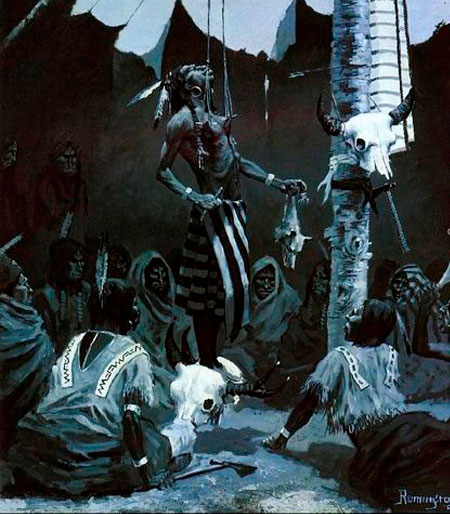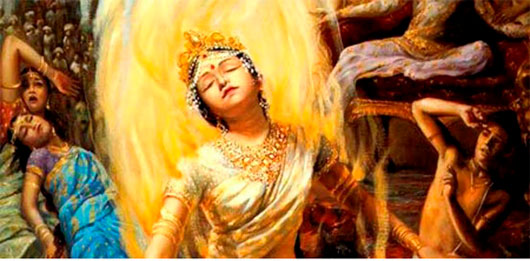8 religious rituals in the world
The tribes, the world in the world have many strange rituals to prove their maturity, to baptize or to pay homage to the gods. And to accomplish them the participants often have to be in danger or experience painful moments of their body.
Okipa: Hang yourself, stab the wood and cut your finger

Made since 1889, the Okipa ritual, a complex ritual of indigenous Mandan Aboriginal people in the United States, marks the maturity of a man in the tribe. To start the ritual, the young men had to fast, fast and not sleep for four days in order to be visited by the soul. Later, they will be taken to a tent where they have to keep smiling faces when they are stabbed through the skin of the chest and muscles.
Then they will use sharp skewers to hang their bodies on the roof of the tent and keep that position until they faint. In order to increase the sense of pain, the heavy fruits are also added to their legs. After fainting, the young man will be taken down and the men of the tribe will wait for him to wake up as a testament to the mature young man's soul. The young man would then offer his little finger to his left hand by having a masked priest in the tribe cut it with an ax.
In the end, the boys will race around the village with wood pieces still on them to determine who is the strongest. Those who complete the ritual will be respected, and those who can go through this ritual twice will be respected for the rest of their lives.
Sati: A wife jumps into the fire according to her husband

Sati is a popular community ritual in India. When the man in a family dies, the wife will have to jump into the fire to 'go' to follow her husband in his funeral. There are many ancient documents detailing the conditions for women's Sati celebrations. Accordingly, if a widow is pregnant, is in a period of menstruation or an irregular menstrual period (a sign of pregnancy), it will not be possible to attend Sati. Another interesting factor is that on the day of the funeral, the wife does not wear mourning clothes but wears the best wedding dress or clothes I have.
This ritual has been performed since 400 AD and most recently in 2008, although the British banned the practice of Sati since 1829 and today the Indian government does not allow it. However, Hindu religions claim that when the widow burned himself, they would become goddesses and be blessed.
Picnic in . graveyard

The Day of the Dead is a ceremony held primarily in Mexico and some countries in the world. The purpose of the ceremony is to let the dead and their relatives meet each other, the soul of the dead will hear the prayers of the living. Those who participate in the festival will recall the fun facts about the deceased.
Holidays will take place from the 1st to the end of November 2 along with the Catholic holidays. Traditionally, people will build a church altar for the deceased and use skulls to make offerings to them. Relatives will also decorate the tomb with food and drink or gifts that dead people love. For children, gifts are usually toys and adults are alcohol. The family of the dead will also bring their favorite sweets as well as blankets to the grave so that the dead can rest and relax. Families can sleep all night at the grave of a dead person without being scared or having fun camping there. Many people carry dolls of dead people to camp.
Crashing into the tongue, nose and throat for baptism
The Matausas tribe in Papua New Guinea practiced baptism for boys to eliminate all the feminine influence left by the boys' mothers. The boys after going through the ritual will become mighty warriors.
Initially, they used 2 wooden sticks inserted into the throat to induce empty stomach vomiting. After that, the wipes are tucked into the boys' noses to repel 'bad influences'. Finally, they stabbed the tongue and throat repeatedly. This ritual ritual works to 'purify' boys to turn them into real men.
Plunge to the ground

Plunging to the ground is a popular ritual in southern Pentecost Island, Vanuatu. The men in the area will jump down from the wooden towers with two tree vines wrapped around the ankle without any safety device. According to beliefs here, the higher the jump from a height, the better the harvest.
Wooden towers also have different heights. The ceremony begins with 8-year-old boys jumping from low altitudes to adults jumping from a height of 20-30m. The ideal jump is the jump from a high altitude and the ground closest to the ground, ie the right shoulder touches the ground. This ritual is quite like a bungee jump except that the vines are not as safe as the protective equipment and the man's head must touch the ground, so it's very dangerous.
The implementer crossed his arms in front of his chest to avoid hand injuries, his head bent down so his shoulders could land. Therefore, the dancer has a great risk of injury like a broken neck. Speed when jumping down can reach 45 mph.
Human sacrifice: Cutting along the body and sacrificing the heart

Human sacrifices are not only attractive characteristics in the Aztec civilization, it is also a religious belief to please the gods and avoid natural disasters.
The Aztecs believed that the best way to give thanks to God was to sacrifice with blood in daily rituals. Instead of destroying enemies on the battlefield, the Aztecs will take the enemy to the village to sacrifice.
The villain will have to climb to the top of the tower through a lot of stairs and when he reaches the top of the priest will cut their body from throat to stomach. After that, the priest will open the heart of the enemy to give to the god. The victim's body will then be thrown down the ladder, disconnected or carried away depending on the ceremony.
Because the Aztecs wanted to sacrifice their enemies, their battle strategy was often to set traps that wounded enemies rather than killing them. Slaves may also be sacrificed, but only if they are too lazy or repurchased 3 times.
Santeria ritual

Santeria is a religion of Caribbean countries that combines elements of West Africa, Caribbean origin, and Christianity (especially Roman Catholicism). In order to become Santeria's priests, ritual participants must undergo a baptismal rite. After baptism, they continue to experience some rituals.
The first ritual is wearing beads that are soaked in a herbal mixture, the blood of the person who wants to become a priest and some other substance in order to be in contact with the god Orichas.
The second ritual is to create the image of Orichas Elegua by sculpting to ward off evil spirits from the priest's house.
The third rite is the ritual of "accepting warriors," the priest will be energized by Orichas, becoming a new person and living with a new destiny. After the ritual ends, the priest will have to wear white and avoid physical contact with others for a year.
El Colacho: Jump over the baby

El Colacho, is a traditional holiday in Spain starting in 1620 which takes place annually to celebrate the Catholic holiday of Corpus Christi in the village of Castrillo de Murcia near Burgos.
During the holiday season there is a ritual called jumping over babies. A girl will spread rose petals to the babies born within the past year. A priest will then bless the children and a man in a devil costume, called Colacho, to jump over the babies lying on the street.
The origin of this ritual has not been elucidated, but its purpose is to ensure safety throughout the life of the baby, helping children avoid illnesses and demons.
- The most gruesome religious ritual in the world
- Close up of mummy monks meditating in flower position
- Fearful rituals to prove the manliness
- The greatest religious places
- Mysterious cemetery of thousands of mummies is not found in Peru
- Mummies of animals nearly 3,000 years old
- Mysterious spider figure on stone during the opening ceremony of mummy mouth
- 12 most mysterious religious phenomena in history
- The 16 most frightening mature rituals in the world
- Ritual of drawing bones on the body of the Chimbu tribe, Papua New Guinea
- 7 most beautiful religious works in the world
- Revealing the reason why prehistoric people cut their fingers
 'Fine laughs' - Scary and painful torture in ancient times
'Fine laughs' - Scary and painful torture in ancient times The sequence of numbers 142857 of the Egyptian pyramids is known as the strangest number in the world - Why?
The sequence of numbers 142857 of the Egyptian pyramids is known as the strangest number in the world - Why? History of the iron
History of the iron What is alum?
What is alum?